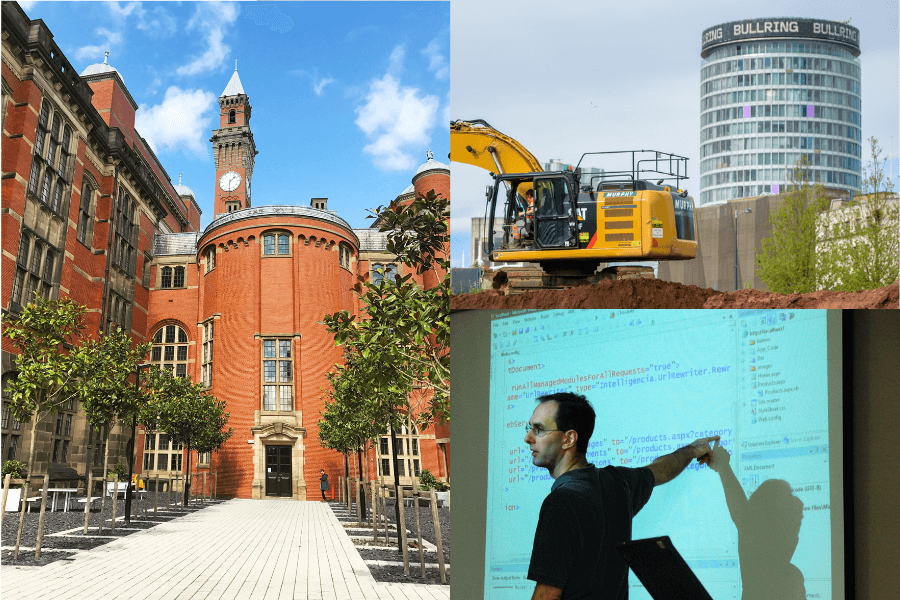 In this piece, Professor Simon Collinson describes the crucial roles to be played by city-regions and by universities if we are going to level up effectively.
In this piece, Professor Simon Collinson describes the crucial roles to be played by city-regions and by universities if we are going to level up effectively.
This article was first posted on the Academy of Social Sciences website.
Over the next few years, the UK faces further challenges which, like the economic impacts of Covid, will worsen the socio-economic inequalities between people and places across the country. We will also have limited levels of public funding for policy interventions to promote more inclusive growth pathways. A fairer distribution of funding is part of the solution. But more intelligent interventions, more precisely aligned to the challenges and growth potential of different places, are particularly needed. Problem-led, collaborative, and interdisciplinary social science can help guide this approach.
The first step is to apply clear, well-specified and (ideally) widely accepted definitions to ambiguous and politicised concepts such as levelling up. This is a basic principle of good social science and will help target a specific set of measurable outcomes and some degree of impact evaluation to shape further interventions. We need a wider set of proxy measures for socio-economic progress, going beyond economic volume (GDP) or efficiency (productivity or GVA) to include reduced inequality, based, for example on the established index of multiple deprivation, and applied as part of a national framework for growth. These would be reported at the aggregate, macro-level (national and regional), but applied to assess the appropriateness and effectiveness of investing public money in specific projects at the micro-level (alongside sustainability measures). More substantial revisions to the Treasury’s Green Book investment appraisal framework by including these broader measures would make a significant difference.
But a more balanced growth trajectory requires local resources and decision-making power to tailor policies for the specific challenges and growth potential of different places. This is the first of three related recommendations I would make to support real progress towards levelling up across the UK.
View all our work on Levelling Up
 1. City-regions are the best places to focus intelligent interventions for balanced growth.
1. City-regions are the best places to focus intelligent interventions for balanced growth.
This point has been made by other contributors to this series (Will Hutton, Diane Coyle). We are about the most centralised OECD nation, in terms of fund-raising and spending powers. This concentrates, standardises, and politicises the mechanisms for bidding, selecting, and funding economic growth propositions. Devolving decision-making responsibility, resources and accountability to regions will enable local coalitions to focus on the distinctive growth potential of their city-regions and improve the accuracy of interventions. Think less about subsidising poor regions in the North using a ‘surplus from the South’ and more about unlocking the economic potential of the whole country. As many commentators have also stated, this will need more than an incremental shift in funding allocations or the small-scale relocation of decision-making (or civil servants).
To unlock this potential and to change the path-dependent growth trajectories of these city-regions requires new funding structures and targeted incentives to develop and leverage detailed local knowledge. Each region is a unique combination of location-specific endowments, including transport and communications infrastructure, industry specialisation (and innovation clusters), skills demand-supply gaps and the many other factors which influence attractiveness to investment and talent and the potential for innovation.
The wide range of policies that support regional growth, including investments in transport systems, R&D or skills programmes, developing science parks or free trade zones or attracting certain kinds of FDI, or relocating civil servants, give rise to complex combined effects. Some produce positive economic multipliers which improve GVA per capita, local spending and employment. But there are trade-offs and displacement effects that can also increase inequality. To improve competitiveness, productivity, and the rate of growth of regions while simultaneously reducing inequalities to achieve levelling up requires locally defined, linked interventions.
 2. Skills are the key link between growth and levelling up.
2. Skills are the key link between growth and levelling up.
Skills are the drivers of innovative capability, productivity and competitiveness for firms, and industry clusters in city-regions and across the country. Better skills enhance our ability to create wealth. But they also improve the employment prospects and household incomes for deprived communities, reducing benefits costs (and crime) and enhancing health and well-being.
Part of the opportunity and the challenge here is to connect these two sides of growth: economic performance, and social equity. Academic thinking as well as policy and practice structures have tended to treat them separately. While Treasury notes a fiscal imbalance in most UK regions, which ‘cost more in subsidies than they earn,’ government departments find it difficult to string together the logic chain between firm performance, skills, incomes, and household resilience. Productivity, poverty, and health are connected, within regional economic systems but not in terms of holistic policy approaches, as noted by others (Jennifer Dixon). Just as there are positive multiplier effects from employment triggered by new investment, there are significant negative knock-on effects from unemployment, the costs of which have yet to be properly calculated. Better skills improve the positive multiplier effects through higher incomes and local spending. Low skills have the opposite effect, lowering incomes and spending while making firms less productive, and poorer communities less resilient and more prone to debt cycles.
This requires academics, policymakers, and ministerial departments (like the Department for Education, the Ministry of Housing, Communities and Local Government, and the Department for Business, Energy and Industrial Strategy) to connect regional data and impact analysis in more holistic approaches to growth interventions. Structural barriers between government departments and the adversarial, hand-to-mouth mechanisms for investment allocations from the centre to city-regions need to change.
 3. Universities can help make innovation central to levelling up
3. Universities can help make innovation central to levelling up
The latest government policy platform focuses on an Innovation Strategy, not for the first time. Being a science superpower is important, but we still struggle with the challenge of becoming an innovation superpower. Invention is a scientific process. Innovation is a socio-economic process, with the active involvement of adopters. This has been known for some time, but the UK default is to focus mainly on investments in science and technology and complain that the Americans and the Chinese commercialise our inventions.
This also means that innovation is non-linear, unpredictable and context-specific. Vaccines are unusual in that a scientific breakthrough leads relatively easily to the adoption and diffusion of a product with obvious value to users everywhere. But even with this critically important innovation, behavioural, social, political, economic and management-related factors have all played a role in determining the pace and pattern of adoption. Most innovations are more complex than this. They evolve through an iterative, emergent, and unpredictable process of adoption, revision and eventual diffusion. This can take a long time or stop at any stage in the cycle for a wide variety of reasons. Social scientists from management and marketing experts to sociologists and economists can help understand and incorporate the behavioural responses of individuals, groups, firms, and other organisations to shape several kinds of innovation pathways that can support balanced regional growth.
All of which indicates how universities can help. As others have also noted (Will Hutton) we have great universities in our city-regions which are central to the Innovation Strategy. Not least because universities are a key source of both skills and frontier science and technology. Often including management skills from business schools and new entrepreneurs. They can and should promote more multidisciplinary, collaborative and problem-led research and teaching. At the same time, focus more on local industry needs, supported by additional incentives and knowledge translation mechanisms. This could involve, for example, building on the Strength in Places Funding (SIPF), the Small Business Charter, and/or Catapults with a regional focus as part of a place-based innovation strategy.
Improving the fit between the supply and demand sides of innovation are key factors in determining whether new technology, knowledge and expertise are exploited to benefit a region. Improving absorptive capacity across local firms and industries to enhance regional innovation systems is partly driven by this alignment. But exploitation means more than commercialisation for improved products, services, and productivity in firms. Innovation in public services and health-care delivery as part of a levelling up agenda can also be boosted by more closely connecting local demand-supply (skills, knowledge, technology) gaps through coalitions of universities, public sector organisations and firms. This will help address both sides of the divide, enabling economic growth which benefits all.
This blog was written by Professor Simon Collinson, Director of City-REDI / WMREDI, University of Birmingham.
Disclaimer:
The views expressed in this analysis post are those of the authors and not necessarily those of City-REDI / WMREDI or the University of Birmingham.
